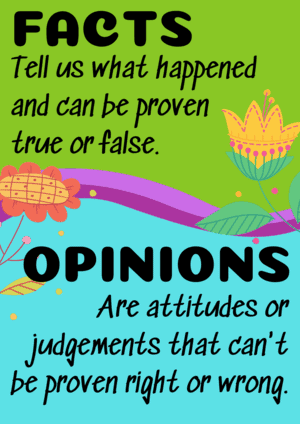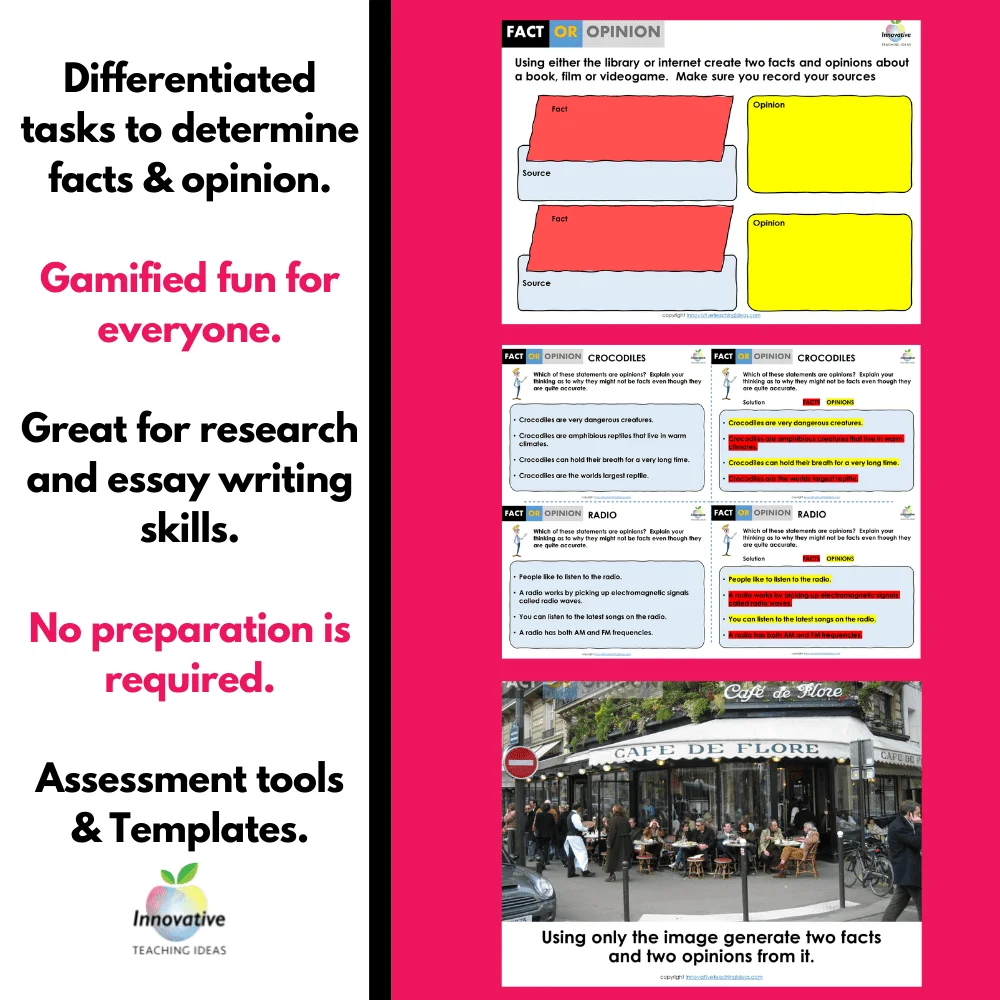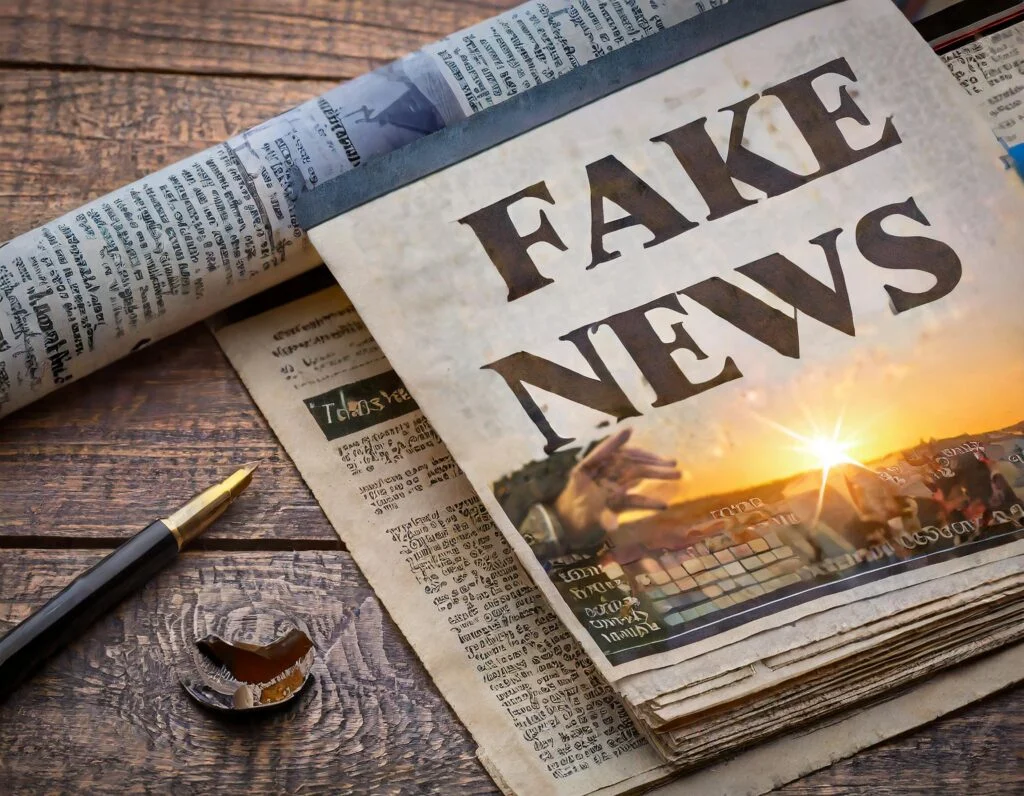
DISTINGUISHING BETWEEN FACT AND OPINION
For higher-level reading comprehension, students must accurately distinguish between fact and opinion. To do this successfully, students must begin with solid definitions of the two concepts. Once this has been achieved, students can practice applying these definitions through activities engaging with a wide range of reading material. Let’s take a look at defining these two all-important concepts before proceeding into strategies and ideas for teaching fact and opinion in the classroom.


WHAT IS A FACT?
A fact refers to something true and can be verified as such. That is, a fact is something that can be proven to be true.
WHAT IS AN OPINION?
An opinion refers to a personal belief. It relates to how someone feels about something. Others may agree or disagree with an opinion but cannot prove or disprove it. This is what defines it as opinion.
Common Fact Vs. Opinion Statements
Facts
- The Earth is round.
- Water freezes at 0 degrees Celsius.
- The Great Wall of China is the longest wall in the world.
- The sun rises in the east and sets in the west.
- The human body has 206 bones.
- The fastest land animal is the cheetah.
- The capital of France is Paris.
- The Nile River is the longest river in the world.
- The Statue of Liberty is located in New York Harbor.
- The United States of America has 50 states.
Opinions
- Pizza is the best food in the world.
- Horror movies are too scary to watch.
- Taylor Swift is the greatest musician of all time.
- Dogs are better pets than cats.
- Chocolate ice cream is better than vanilla ice cream.
- Politics is too complicated to understand.
- Exercise is essential for a healthy lifestyle.
- The internet is the greatest invention in human history.
- Living in a big city is better than living in a small town.
- The color blue is the most calming color.
IDENTIFYING FACT FROM OPINION IS AN ESSENTIAL SKILL FOR STUDENTS
The ability to distinguish between fact and opinion helps students develop critical and analytical skills in reading and listening. Fact and opinion are often woven together in texts and speeches. It is, therefore, imperative that students can unravel the threads of what is true from what is mere belief if they are to navigate the deluge of media successfully they will encounter in their lifetimes.
Whether on the news, in advertising, or in a history book, learning to distinguish between what is fact and what is opinion is crucial to becoming an autonomous consumer with the critical thinking skills to avoid being manipulated easily.
The Language of Facts AND OpinionS: Signal Words and Phrases
Writers will liven up their facts with a sprinkling of opinions. Unfortunately, it can sometimes be challenging to extract the verifiable truths from the author’s preferences and biases. Luckily, the language used often throws up helpful clues in the forms of words and phrases that assist us in identifying statements as fact-based or opinion-based.
Let’s now take a look at some examples of those signal words and phrases being used in the sentence fragments that often precede a statement of fact or opinion:
FACT SIGNAL WORDS
- The annual report confirms…
- Scientists have recently discovered…
- According to the results of the tests…
- The investigation demonstrated…
OPINION SIGNAL WORDS
- He claimed that…
- It is the officer’s view that…
- The report argues that…
- Many scientists suspect that…
As we can see from the signal word examples, the language used to introduce fact, and opinion statements can help indicate whether it is being framed as a fact or an opinion.
Students must understand that things are not always as they appear to be. At times, writers, whether consciously or not, will frame opinion as fact and vice versa. This is why it is vital that students develop a clear understanding of what constitutes fact and opinion and are afforded ample opportunities to practice distinguishing between the two.
WHAT IS CONTEXT?
Context is the circumstances surrounding an event, statement, or idea and in terms of which it can be fully understood. Facts and opinions must be placed in context to draw conclusions, and they can significantly impact the importance we place upon statements of fact and opinion.
For example, a young boy who tells his mother, “I ate a truckload of sweets at the party last night” needs to be placed in the context of his age and audience.
We can confidently infer he never actually ate a real truckload of sweets, but we can reasonably appreciate he ate a lot of them and wanted to emphasise that point. His mother might ask a clarifying question to turn that opinion into a hard fact.
Context provides the background information or circumstances that help us understand the meaning of facts and opinions.
For instance, if we say the factual statement, “it’s raining outside”, the context may differ depending on the situation. If we’re at home, it might mean we must stay inside or find something to do indoors. If we’re at a sports game, it might affect the playing conditions or attendance.
Similarly, the context of an opinion can vary based on the situation. For example, if someone says, “I don’t like spicy food”, the context might include their previous experiences with spicy food or the cultural norms of the cuisine they’re discussing. Understanding the context helps us understand the meaning and implications of what someone is saying.
THE CHALLENGES OF TEACHING FACT AND OPINION IN THE “POST-TRUTH” ERA
Teaching students to differentiate between fact and opinion is a complex task that requires educators to navigate a number of challenges that have only accelerated in the “Post-Truth” era, in which some members of society cannot accept being wrong on a particular issue, even with an ocean of evidence stacked against them.
One of the key challenges is that students often come to the classroom with preconceived notions and biases that can make it difficult for them to accept certain facts.
This is not a new phenomenon. Throughout history, individuals and groups have clung to their beliefs despite overwhelming evidence to the contrary. For example, in the 16th and 17th centuries, many people still believed that the Earth was the center of the universe, despite the mounting evidence to the contrary.
Today, we face a similar challenge when teaching students about scientific issues such as climate change. Some students may come from families or communities that deny the existence of climate change, despite the overwhelming scientific evidence that supports it. In such cases, educators must find ways to engage with students respectfully and constructively, while also presenting the scientific evidence clearly and compellingly.
Another challenge educators face when teaching fact and opinion is that students may struggle to distinguish between the two when presented together. This is particularly true in news media, where news articles often include a mixture of factual information and opinions from various sources.
In such cases, educators must teach students to critically evaluate the sources of information they encounter and distinguish between factual information and opinions. This requires a deep understanding of the media landscape, as well as an ability to evaluate the information that is presented critically.
Teaching Resources
Use these resources and tools to improve your student’s media literacy skills through proven teaching strategies.
Fact Vs. Opinion TEACHING activities
Fact and Opinion Activities: Honing the Skills
To become a skilled, critical reader, a student must develop the ability to evaluate a text for facts and opinions quickly. To achieve this, they must practice distinguishing between fact and opinion to a point where it becomes a subconscious mechanism. The activities below will afford your students these necessary opportunities. They can also easily be adapted to various ages and abilities by carefully selecting the reading material.
Student Activity 1. Top 10 Facts and Opinions
Not only does this simple activity help students hone their fact and opinion-detecting abilities but serves as a great warm-up research activity when beginning a new topic in class.
When starting a new topic, whether on a historical period, a literary figure, or a species of animal, set students to list ten facts and opinions from their background reading and research on their new topic. Students must then form and record ten opinions based on reflection on this initial reading and research.
It may also be a valuable exercise for students to review their opinions at the end of the topic. Have they changed their opinion in any areas of the topic? Why did they change or maintain their opinion? This can work as a great review activity to wrap things up.

Student Activity 2. Evaluate an Editorial
Newspaper editorials can be a superb resource for students to practice recognizing facts and opinions. They are filled with the editor’s opinions on the day’s issues, intermingled with facts selected to support that view.
First, give students copies of a newspaper editorial. Then, working in pairs, have students go through the editorial to identify the facts by underlining them and the opinions by highlighting them. Remind them to look for the signal words we covered earlier to help identify facts and opinions.
When finished, students can compare their answers and discuss the reasons for their decisions. This will help identify any areas of confusion within the class, providing valuable data to inform your future planning on this topic.
Student Activity 3. Fact vs Opinion Survey
This activity can initially be undertaken using statements compiled on a worksheet. Later, students can work through text passages or a textbook itself directly. Students work through a series of statements marking either F or O beside each to identify that statement as a Fact or an Opinion.
This activity is a practical study preparation exercise as it helps students to filter factual content from opinion. It also makes it easier for students to work out the underlying purpose of a text, whether it is designed to inform, persuade, or entertain. Students will soon begin to recognize that passages of text that contain more facts than opinions are most likely intended to inform. In contrast, a more opinion-based text will most likely be designed to persuade or entertain.
Student Activity 4. The Great Fact or Opinion Sort

Organize students into reasonable-sized groups of four or five students. Provide each group with a jar containing a set of cards, each with a fact-based or an opinion-based statement printed on it. Students take turns picking a card from the jar and reading it to the group. The group discusses each statement before deciding if it is a fact or an opinion.
Students can then record the statements accordingly on the Fact and Opinion graphic organizer described above or sort them into two piles.
This activity effectively supports struggling students as they learn from those who have already developed a firmer grasp of the two concepts.
Extension Exercise: Identifying Bias
One reason it is so vital for our students to learn to differentiate between fact and opinion is that this ability is a stepping stone to detecting bias in a text. Students begin to evaluate a text for bias by identifying how much of the text is fact-based and how much is based on opinion.
Once this is done, students must then analyse whether the opinions expressed in the text are biased by considering whether the writer has:
- Provided incomplete information
- Intentionally ignored or left out information to persuade the reader
- Allowed their own personal experiences to cloud any sense of objectivity.
FACT vs OPINION GRAPHIC ORGANIZERS
Graphic organizers are a great tool to help students sort the facts and opinions in a text. Offering, as they do, a very visual means of organizing information, graphic organizers help students drill their ability to identify differences between fact and opinion statements until they become automatic.
The Fact and Opinion Chart
This simple chart consists of two columns helpfully labelled fact and opinion beneath a topic heading. Students work through a text, sorting statements as they come across them into the appropriate column on the graphic organizer. At the end of this task, they will be left with a clear segregation of the statements of the text according to whether they are objective facts or subjective opinions.
READ OUR GREAT ARTICLE ON LITERACY GRAPHIC ORGANIZERS HERE
IN CONCLUSION
Not only is the ability to identify bias in the writing of others essential, but this knowledge will also be of great benefit to students when it comes to forming and expressing their own opinions.
Taking the time to prepare and deliver discrete lessons on recognising facts and opinions in reading is essential. No matter how confident students are in distinguishing between the two, they are still likely to benefit from further practice. Even the most reflective of us can sometimes remain ignorant of our biases!
Becoming the critical readers that our students aspire to become begins with forming clear definitions of the terms in the student’s minds. These definitions must be supported by examples and illustrations to achieve this. Student understanding must be further underpinned by classroom and home practice. The activities above serve as a good starting point, but they are not sufficient on their own.
It will be necessary to support students further to gain a deeper understanding of fact and opinion (and related concepts such as bias) by frequently referencing these concepts when engaged with students in lessons with other explicit objectives seemingly unrelated to fact and opinion. Reinforcement should be persistent to ensure students develop firm skills in this area.
With ongoing technological advances, assessing the reliability and truthfulness of the media, we consume daily has never been more challenging – or essential.
















